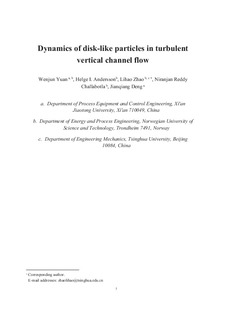| dc.contributor.author | Yuan, Wenjun | |
| dc.contributor.author | Andersson, Helge Ingolf | |
| dc.contributor.author | Zhao, Lihao | |
| dc.contributor.author | Challabotla, Niranjan Reddy | |
| dc.contributor.author | Deng, Jianqiang | |
| dc.date.accessioned | 2018-04-26T12:13:12Z | |
| dc.date.available | 2018-04-26T12:13:12Z | |
| dc.date.created | 2017-09-29T03:21:23Z | |
| dc.date.issued | 2017 | |
| dc.identifier.citation | International Journal of Multiphase Flow. 2017, 96 86-100. | nb_NO |
| dc.identifier.issn | 0301-9322 | |
| dc.identifier.uri | http://hdl.handle.net/11250/2496152 | |
| dc.description.abstract | The dynamical behavior of inertial disk-like particles in turbulent vertical channel flow is investigated by an Eulerian–Lagrangian point-particle approach. Gravity effects on distribution, translation, rotation and orientation statistics of non-spherical particles modeled as oblate spheroids have been studied both in an upward and a downward flow and compared with results obtained in the absence of gravity. Altogether 12 different particle classes have been studied, with inertia and shape parameterized by means of Stokes number St and aspect ratio λ ≤ 1. The St = 5 disk-like particles distribute more evenly across the channel in upward than in downward flow. The gravity effect on the particle concentration diminishes with large inertia and the spheroid shape has only a modest influence. Although the gravity significantly affects the streamwise and wall-normal mean slip velocities with increasing inertia, the particle shape rarely has any impact on the translational motion, except for the mean wall-normal velocity. The fluctuations of the velocity of disk-like particles are mainly ascribed to inertia, whereas the gravity and shape only have marginal effects. The presence of gravity is moreover found to have a negligible effect on the particles’ orientation and rotation, in spite of the striking effect of λ on the orientation and rotation seen in the near-wall region. The tendency of the disks to align their symmetry axis orthogonal to the fluid vorticity in the channel center is stronger for particles with modest inertia. In the near-wall region, however, oblate spheroids preferentially align with the fluid vorticity for St >> 1. The observed behavior is believed to be caused by the influence of the gravity force on the turbophoresis; i.e. that inertial particles move towards low-turbulence regions. | nb_NO |
| dc.language.iso | eng | nb_NO |
| dc.publisher | Elsevier | nb_NO |
| dc.rights | Attribution-NonCommercial-NoDerivatives 4.0 Internasjonal | * |
| dc.rights.uri | http://creativecommons.org/licenses/by-nc-nd/4.0/deed.no | * |
| dc.subject | Turbulens | nb_NO |
| dc.subject | Turbulence | nb_NO |
| dc.subject | Partikler | nb_NO |
| dc.title | Dynamics of disk-like particles in turbulent vertical channel flow | nb_NO |
| dc.type | Journal article | nb_NO |
| dc.type | Peer reviewed | nb_NO |
| dc.description.version | acceptedVersion | nb_NO |
| dc.subject.nsi | VDP::Teknologi: 500 | nb_NO |
| dc.subject.nsi | VDP::Technology: 500 | nb_NO |
| dc.source.pagenumber | 86-100 | nb_NO |
| dc.source.volume | 96 | nb_NO |
| dc.source.journal | International Journal of Multiphase Flow | nb_NO |
| dc.identifier.doi | 10.1016/j.ijmultiphaseflow.2017.06.008 | |
| dc.identifier.cristin | 1500072 | |
| dc.relation.project | Norges forskningsråd: 250744 | nb_NO |
| dc.relation.project | Notur/NorStore: NN2649K | nb_NO |
| dc.description.localcode | © 2017. This is the authors’ accepted and refereed manuscript to the article. Locked until 24.6.2019 due to copyright restrictions. This manuscript version is made available under the CC-BY-NC-ND 4.0 license http://creativecommons.org/licenses/by-nc-nd/4.0/ | nb_NO |
| cristin.unitcode | 194,64,25,0 | |
| cristin.unitname | Institutt for energi- og prosessteknikk | |
| cristin.ispublished | true | |
| cristin.fulltext | postprint | |
| cristin.qualitycode | 1 | |

